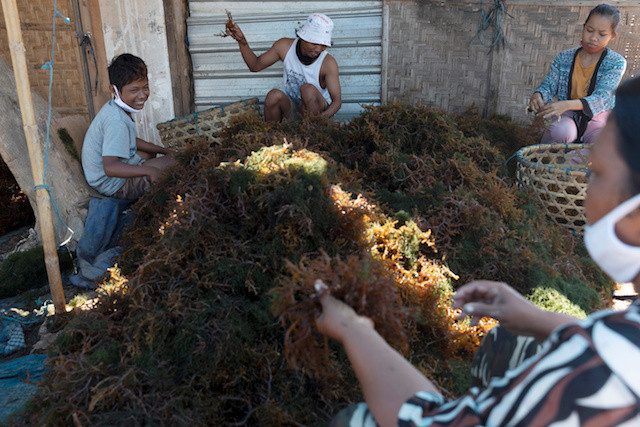Popular Reads
Top Results
Can't find what you're looking for?
View all search resultsPopular Reads
Top Results
Can't find what you're looking for?
View all search resultsFunding, research hamper Indonesia’s seaweed potential for biofuel
As the world's largest seaweed exporter, the commodity has the potential to help Indonesia achieve net zero target, but challenges on funding and research stand in the way.
Change text size
Gift Premium Articles
to Anyone
I
ndonesia, the world’s largest seaweed exporter, is considering the commodity’s use in producing bio-crude to help reduce the country’s reliance on costly imported crude. Though the potential for seaweed-based biofuel is huge, much still needs to be done to turn the idea into reality.
The Energy and Mineral Resources Ministry said on Jan. 19 that seaweed-based biofuel could compete with the cost of other biomass, such as corn, sugarcane and cassava, which required a vast amount of land for cultivation.
Seaweed is more sustainable than other plants used to make biofuel, according to a joint study by researchers from state-run Diponegoro University and South Korea’s Pukyong National University, so it is considerably more preferable in pursuing the country’s net zero agenda.
Indonesia is aiming to produce biofuels to significantly reduce its imports of costly fossil fuels, including crude oil, the ministry has reiterated on many occasions.
Energy minister Arifin Tasrif said he was open to the idea of using seaweed to produce biofuel, but the government would need to study this further to gain a better understanding of its feasibility and potential costs as well as ways to address the financing challenges.
“We think innovation has to be more intense and the [research] funds has to be more available, and then the market should be opened by regulations and [actual] demand,” Arifin said on Jan. 19 at the World Economic Forum Annual Meeting 2023 in Davos, Switzerland.
Read also: Diverse, sustainable biofuels crucial for Indonesia’s energy transition
According to 2021 data from the United Nations Comtrade database, Indonesia is the largest seaweed exporter in the world and has an annual export volume of more than 187,000 tonnes valued at US$219 million. It also ranks fourth in seaweed exported for industrial use with a total of 21,452 tonnes. These figures indicate the country’s potential in the global seaweed industry.
Yonvitner, who heads the Center for Coastal and Ocean Resources Studies (PKSPL) at IPB University, said a large part of Indonesia’s seas remained untouched, despite their potential to sustain larger seaweed cultivation needed for uses other than food, like biofuels.
Cultivating seaweed required less effort and lower costs than land biomass, which carried extra costs for fertilizers, pesticides and other materials to grow, he said.
“All we need to do is plant the seaweed and let it grow [naturally], simple,” Yonvitner told The Jakarta Post on Monday.
Beyrra Triasdian, a lecturer at Jenderal Achmad Yani University who focuses on renewable energy technology, said the government should take precautionary steps prior to scaling up seaweed cultivation for use in biofuel, pointing to the risks mass production posed to local ecosystems.
“We don’t yet know how to sustainably replenish the nutrients in the sea,” Beyrra told the Post on Monday.
Data from East Sumba, East Nusa Tenggara, showed that local seaweed plantations could not be developed further because of the deteriorating level of nutrients in the seas surrounding the regency, she added.
Furthermore, seaweed production in Indonesia was on a declining trend, while the current supply was deemed insufficient for wide use in research and development, Beyrra added. This would prevent further research into seaweed’s potential as a renewable energy source.
Data from the Maritime Affairs and Fisheries Ministry show that nationwide seaweed production has steadily declined in recent years, from nearly 10 million tonnes in 2016 to 7 million tonnes in 2021.
Read also: Indonesia to enact mandatory B35 biodiesel program as global CPO prices fall
Existing seaweed plantations like those in East Sumba, are run by local farmers for export, primarily for human consumption. Although the regency has over 15,000 hectares of shallow seas suitable for seaweed cultivation, only 2.5 percent was utilized, said a 2019 report by the Food and Agriculture Organization (FAO).
The lack of good aquaculture practices was why the seaweed industry could not be expanded, added the FAO report.
“We only barely covered 25 percent of the national demand for seaweed this year. We don’t have enough to support further trials when we haven’t fully met the demand,” Beyrra said.
Nelson Vadassery, cofounder of ocean farming start-up Sea6 Energy, said a ton of seaweed biomass need to cost less than $100 to be competitive enough to replace crude from fossil fuels, albeit currently the actual cost still times larger than the ideal amount.
To cut costs, seaweed industries need to scale up by mechanizing ocean farming and increasing yield with improved seeds, but unlocking the potential is still difficult due to lack of financing and investors for seaweed is not as mainstream like other source of biofuel, Nelson said.
However, seaweed technology is promising and it may be better option than other source of biofuel, he said, arguing it would not compete with food supply, cause deforestation and disrupt fresh water supply like crops grown on land.
--The writer is an intern at The Jakarta Post.










